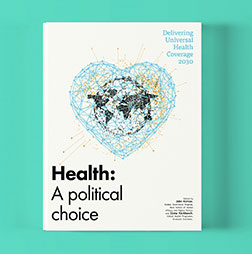UN HLM on Non-communicable Diseases and Mental Health – A case of same old, same old?
A Guyanese colleague recently suggested that non-communicable diseases should be called ‘preventable killer diseases’ to command more attention. Arguably, NCDs are a global pandemic, with a huge number of people harmed and the need for the highest-level cross-sector attention and collaboration, which is what September’s United Nations High Level Meeting on Non-communicable Diseases and Mental Health was intended to provide.
A pandemic is the simultaneous worldwide occurrence of a disease. Typically referring to infectious diseases, such as the Spanish flu or Covid-19, the term has been used in relation to cigarette smoking, obesity and gambling, given the global nature of these challenges and their health, social and economic impacts.
The main NCDs are cardiovascular disease including heart disease and stroke, diabetes, cancer, chronic respiratory diseases such as asthma and mental ill health. NCDs kill 43 million people annually, 18 million of whom are in people under 70 years old. The major risk factors include tobacco use, harmful use of alcohol, poor quality diets, inadequate physical activity and air pollution.
These behavioural risks are determined by a range of social and environmental factors, including powerful transnational commercial determinants. Added to this is the overarching threat of climate change, with increasing heat and extreme weather and damage to health systems having undue impact on people with NCDs.
The political declaration of the fourth HLM on NCDs and mental health has reaffirmed Sustainable Development Goal 3’s target to reduce premature mortality from NCDs by one-third – adopted in 2015 by all UN members. But few countries are on track to achieving it and the question has to be asked – why?
The struggle is real
Human-caused climate change from burning fossil fuels with increasing heat, air pollution, destructive storms and extreme weather are among the main impediments. Lack of financing, political economy issues, poor coordination of efforts and serious conflicts of interest with health-harming industries are other barriers.
NCDs are preventable through medical care. They are also preventable through personal choice, although that is illusory considering the influence of commercial and environmental determinants. The health-harming industries of big tobacco, big alcohol, big food and big oil all follow a common playbook of denying, deflecting, delaying, funding bogus studies to undermine the science and buying policy makers in various ways.
What results should the HLM HAVE produceD?
The HLM in September followed similar meetings in 2011, 2014 and 2018, catalysed by the first ever meeting of heads of government of the Caribbean on NCDs
in 2007.
What results the HLM should and does produce are two different things. It should lead to a 30% reduction in premature mortality from NCDs by 2030. It produced the ‘same old’ lack of progress, even though the political declaration notes there are 1.3 billion tobacco users, 1.3 billion adults living with hypertension – a doubling since 1990, 800 million adults living with diabetes – a fourfold increase since 1990, and 41 million children under five being overweight or obese, while adult obesity has more than doubled since 1990.
Moreover, despite acknowledging the huge health impact and mental health burden of NCDs, the economic impact is understated, for example, as a major factor in bankrupting social security systems worldwide. Small island developing states get a special mention, given their vulnerability.
The value of lived experience of people with NCDs is recognised. However, the declaration is still largely stuck on risk factors and medical care, and many indicators are vague, as pointed out by the NCD Alliance. There is little reference to the social, commercial and environmental determinants of health. ‘Commercial’ is mentioned twice in passing, although the health-harming industries’ playbook drives both the NCD pandemic and climate change, putting profit before the health of people or planet. There is little mention of the huge role of ultra-processed foods (high in sugar, salt, fat or overall calories) propelling the obesity pandemic and produced by a handful of transnational companies.
‘Climate’ is mentioned once in the context of climate emergencies worsening NCDs, but heat, which is killing in ever increasing numbers, is never mentioned. Air pollution, which kills around 7 million people annually, is hardly mentioned, and its main cause, burning fossil fuels, is not mentioned at all. The impacts of climate-exacerbated floods and drought on food and nutrition security are not mentioned.
What political choices are needed now?
Political leaders need to grasp the big picture that NCDs are symptoms of the failure of our development paradigms. They need to see that NCDs are driven mostly by social and environmental causes, including access to health care, with climate change an overarching threat. They need courage and vision to tackle the commercial determinants directly, have health join forces with climate and environmental action, and adopt a true all-of-society approach with robust measures to address conflicts of interest.
Leaders need to see that climate action has significant health co-benefits – more plant-rich diets and alternative transportation such as biking and walking with facilitative urban greening are good for health and the planet.
Endorsing the Fossil Fuel Non-Proliferation Treaty, bolstered by the International Court of Justice advisory opinion on climate change, both pioneered with SIDS leadership, would also be steps in the right direction. This year’s G20 summit in Johannesburg, South Africa, and the UN climate conference in Belém, Brazil, should both also address this nexus between NCDs and climate change.












